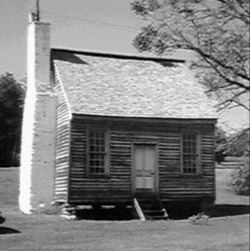Added to NRHP 15 October 1966 | Visitation 185,443 (2009) Nearest city Appomattox | |
 | ||
Similar Appomattox Court House N, Bocock‑Isbell House, Mariah Wright House, Old Appomattox Court Ho, New County Jail | ||
Music at the charles sweeney cabin appomattox virginia
The Charles Sweeney Cabin is a structure within the Appomattox Court House National Historical Park. It was registered in the National Park Service's database of Official Structures on June 26, 1989.
Contents
- Music at the charles sweeney cabin appomattox virginia
- At the charles sweeney cabin appomattox court house nhp may 2015
- History
- Historical significance
- Description
- References
At the charles sweeney cabin appomattox court house nhp may 2015
History
Charles Sweeney was the cousin of Joel Sweeney, the person that popularized the five-string American banjo. In the 1840s the Sweeney clan lived on the stagecoach road northeast of Clover Hill, the name of the village now known as the Appomattox Court House National Historical Park. John Sweeney, a wheelwright and Charles' brother, lived in the old family home on the north bank of the Appomattox river with his wife and four children. When Joel was not touring the country entertaining he would stay at John's cabin. Just up the road the four children of John's, being nephews and nieces of Charles, could see their uncle's small cabin. Charles lived in the tiny cabin with his wife and two remaining children. Charles Sweeney's older son Robert, a left-handed fiddle player, lived in even a smaller cabin with his wife and baby daughter downhill from John. Charles Sweeney was born in 1794 as was his wife, Mary.
Historical significance
The National Park Service states the Charles Sweeney Cabin is meaningful by virtue of its association with the site of General Robert E. Lee's surrender to General Ulysses S. Grant. There is some evidence, in the form of a circa 1930 post card, which indicates that General Fitzhugh Lee and his staff stayed in this house the night before the Surrender. It was originally built between 1830 and 1840 by Charles Sweeney, altered between 1940 and 1950, and restored in 1988 and 1994.
Description
The Charles Sweeney Cabin is a single-story one-room structure with a loft. It is about twenty feet wide by about eighteen feet deep. The cabin is a post and beam hall house set on dry-laid fieldstone pier foundation, typical of what was in rural Virginia in the nineteenth century. The hall house consists of a "hall" or keeping room, that was the main room of the cabin. It served as an assortment of various rooms when needed; consisting of a living room, dining room, kitchen, workroom and bedroom. Cooking was done in a fireplace that was set to one end of the large room.
A rough, crudely quoined, fieldstone chimney extends to the second floor and above with brick. There are windows on the north, south and east sides. The south and east sides have single four-paneled doors. The interior of the cabin is in good condition. The roof is made of oak shakes, square-butted, and is supported at the eaves by a box cornice. The ends are covered with scribed end boards.
The one-room interior of the Charles Sweeney Cabin has a loft accessible in the northwest corner by a dog-leg stairway. The stairway has many of its original balusters. It also has original trim on the stringers, the structural member of the stairway that supports the treads and risers. The square newel and rail are formed from one piece of an oak branch. There is a small closet under the staircase that has its original four-paneled door with concave, quarter-circle corners on the raised panels.
All the inside of the "hall" room exposed to the eye is whitewashed. The door and window surrounds suggest the cabin was intended to be, but never was, plastered. The east side has a four-paneled door which is flanked by 6/6 double hanging sash windows. The east side has a single centered four-panel door on the main floor that opens directly into the multi-purpose keeping room. Above is a six-light (eight foot by twelve inch) casement. The north side has a single 6/6 double hanging window. Hewn oak L-formed corner posts and knee braces alternate with the secondary members made of pine.
